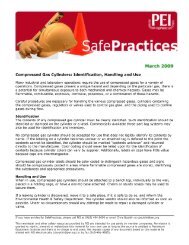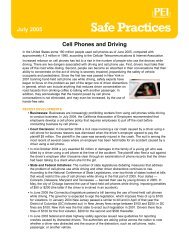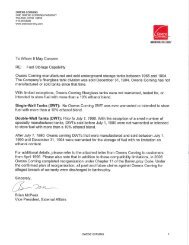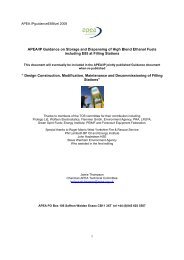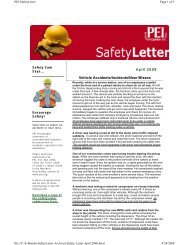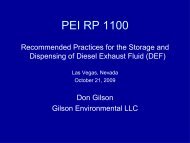- Page 1 and 2: The Administrator signed the follow
- Page 3 and 4: DATES: Comments must be received on
- Page 5 and 6: Category NAICS 1CodesIndustryIndust
- Page 7 and 8: 3. Renewable Fuel Exempt from 20 Pe
- Page 9 and 10: E. Concept for EPA Moderated Transa
- Page 11 and 12: F. Total GHG Emission ReductionsG.
- Page 13 and 14: XI.C. Additional Water Issues1. Che
- Page 15 and 16: I. IntroductionThe current Renewabl
- Page 17 and 18: analyzed the lifecycle GHG impacts
- Page 19 and 20: II.Overview of the Proposed Program
- Page 21 and 22: iofuel or biomass-based diesel is a
- Page 23 and 24: For other renewable fuels, EISA mak
- Page 25 and 26: of important trends in agricultural
- Page 27 and 28: not been assessed to participate in
- Page 29 and 30: finalized. Rather, the current RFS1
- Page 31 and 32: However, for the 2010 compliance ye
- Page 33: In a similar fashion, while we reco
- Page 37 and 38: misleading characterization. For th
- Page 39 and 40: We note that the aggregate nationwi
- Page 41 and 42: Table II.B.4-1 Changes from the 200
- Page 43 and 44: III.What are the Major Elements of
- Page 45 and 46: Table III.A-2 Alternative D Code De
- Page 47 and 48: engines, and the producer generally
- Page 49 and 50: Approximately 35% by weight of MSW
- Page 51 and 52: d. Biomass-Based DieselUnder today
- Page 53 and 54: Renewable fuel: The 20% threshold o
- Page 55 and 56: comment, however, on the alternativ
- Page 57 and 58: when they are replaced; and 5) Inde
- Page 59 and 60: Our guiding philosophy of protectin
- Page 61 and 62: wheat, barley, oats,rice, or sorghu
- Page 63 and 64: also whether the costs of repairs a
- Page 65 and 66: As discussed in Section 1.5.1.3 of
- Page 67 and 68: incidental increases in volume due
- Page 69 and 70: agricultural land that facilitates
- Page 71 and 72: While enforcement of the overall re
- Page 73 and 74: had never been cleared or cultivate
- Page 75 and 76: commonly understood definitions to
- Page 77 and 78: many cases, the programs respond to
- Page 79 and 80: We seek comment on incorporating by
- Page 81 and 82: circumstances under which a batch o
- Page 83 and 84: ii.Third-Party ProgramsTo inform ou
- Page 85 and 86:
is eligible for RINs, renewable fue
- Page 87 and 88:
consumption, thereby minimizing any
- Page 89 and 90:
mapping website to assist regulated
- Page 91 and 92:
failing to make any demonstration r
- Page 93 and 94:
emission reduction thresholds for e
- Page 95 and 96:
enefits of higher credit value as d
- Page 97 and 98:
establish “appropriate” credit
- Page 99 and 100:
Although there are several reasons
- Page 101 and 102:
could be applied, it would be modif
- Page 103 and 104:
Table III.D.2.a-1 Alternative D Cod
- Page 105 and 106:
production process and feedstock to
- Page 107 and 108:
3. The imported renewable fuel is n
- Page 109 and 110:
comment on whether a selection of p
- Page 111 and 112:
on feedstock mass and translating t
- Page 113 and 114:
would in turn require a facility-sp
- Page 115 and 116:
involves the process of capturing C
- Page 117 and 118:
lender or importer to determine the
- Page 119 and 120:
equires EPA to use an EIA estimate
- Page 121 and 122:
Std BBD,i =Std AB,i =Std RF,i =RFV
- Page 123 and 124:
2010. As described more fully in Se
- Page 125 and 126:
enewable fuel mandate in this manne
- Page 127 and 128:
elieve this approach would provide
- Page 129 and 130:
were also used to meet the total re
- Page 131 and 132:
c. Alternative Approach to Treatmen
- Page 133 and 134:
the addition of oxygenate blended d
- Page 135 and 136:
producers cannot readily differenti
- Page 137 and 138:
enewable fuel standard. In contrast
- Page 139 and 140:
valid for meeting the cellulosic bi
- Page 141 and 142:
sufficient RINs. The result might b
- Page 144 and 145:
Under RFS2, there are four possible
- Page 146 and 147:
auction. This could be through an E
- Page 148 and 149:
meet the levels in EISA we will con
- Page 150 and 151:
case, the obligated party would eff
- Page 152 and 153:
purposes. As with the existing rene
- Page 154 and 155:
parties. It is our intention to con
- Page 156 and 157:
under this scenario, unless that pa
- Page 158 and 159:
necessary to ensure the RFS2 progra
- Page 160 and 161:
exemption to the few remaining smal
- Page 162 and 163:
We propose to include elements of R
- Page 164 and 165:
Or, would an intermediate value bet
- Page 166 and 167:
obligated parties determine complia
- Page 168 and 169:
RINs must be generated to identify
- Page 170 and 171:
Once registration occurs with EMTS,
- Page 172 and 173:
Implementation of EMTS should save
- Page 174 and 175:
V. Assessment of Renewable Fuel Pro
- Page 176 and 177:
2. Control Case for AnalysesOur ass
- Page 178 and 179:
We needed to make this projection s
- Page 180 and 181:
Another thermochemical plant could
- Page 182 and 183:
much smaller feedstock supplies are
- Page 184 and 185:
emissions. As described more fully
- Page 186 and 187:
decomposition of organic matter, as
- Page 188 and 189:
As shown in Figure V.B.1-1, U.S. et
- Page 190 and 191:
previously-mentioned wet mill facil
- Page 192 and 193:
product comes from 38 plants owned
- Page 194 and 195:
Table V.B.1-5 Projected RFS2 Corn/S
- Page 196 and 197:
Table V.B.1-7 Projected RFS2 Corn/S
- Page 198 and 199:
Table V.B.2-1 Existing Cellulosic B
- Page 200 and 201:
Table V.B.2-2 Cellulosic Biofuel Pl
- Page 202 and 203:
its 40 million-gallon-per-year cell
- Page 204 and 205:
Later that same month, DOE announce
- Page 206 and 207:
Sector experts for forestry biomass
- Page 208 and 209:
See Section III.B.4 for a discussio
- Page 210 and 211:
secondary storage will add addition
- Page 212 and 213:
species (i.e. native species after
- Page 214 and 215:
v. Cellulosic Plant SitingFuture ce
- Page 216 and 217:
analysis provides a reasonable appr
- Page 218 and 219:
and be net importers of ethanol, th
- Page 220 and 221:
each year as 7% of the total domest
- Page 222 and 223:
started up in 2010. Also, numerous
- Page 224 and 225:
whether it was BQ-9000 certified. 1
- Page 226 and 227:
2022, generating approximately 150
- Page 228 and 229:
will be used. While some uncertaint
- Page 230 and 231:
However, the location of ethanol pl
- Page 232 and 233:
facilities would need to ensure tha
- Page 234 and 235:
storage tanks. Because of its high
- Page 236 and 237:
Significant private and public reso
- Page 238 and 239:
We request comment on the extent to
- Page 240 and 241:
Another question is whether the sto
- Page 242 and 243:
equipment. 197 Equipment manufactur
- Page 244 and 245:
Table V.D.1-1U.S. Ethanol Consumpti
- Page 246 and 247:
illion gallons of ethanol by 2022 (
- Page 248 and 249:
222,223cars. We also assumed that a
- Page 250 and 251:
2008. 233 This means that, on avera
- Page 252 and 253:
waive/reduce E85 fuel taxes under R
- Page 254 and 255:
level blend would need to have a wa
- Page 256 and 257:
Figure V.D.3-1 Max E15/E20 Ethanol
- Page 258 and 259:
normal processes used by these stan
- Page 260 and 261:
that the fuel manufacturer could im
- Page 262 and 263:
preferentially investigate diesel f
- Page 264 and 265:
would be less appropriate than meas
- Page 266 and 267:
EPA seeks comment on all of the iss
- Page 268 and 269:
VI.Impacts of the Program on Greenh
- Page 270 and 271:
land conversion GHG emissions facto
- Page 272 and 273:
about international land use change
- Page 274 and 275:
distinguish biofuel on the basis of
- Page 276 and 277:
Drawing a distinction between GHG e
- Page 278 and 279:
It is important to establish clear
- Page 280 and 281:
For some steps in the production of
- Page 282 and 283:
efforts that estimate potential imp
- Page 284 and 285:
As described previously, GHG emissi
- Page 286 and 287:
ii.International Agricultural Secto
- Page 288 and 289:
Both our FASOM and FAPRI models acc
- Page 290 and 291:
overseas production. In addition, t
- Page 292 and 293:
organization, to address this quest
- Page 294 and 295:
use change data is capturing some o
- Page 296 and 297:
general equilibrium stage. We reque
- Page 298 and 299:
time profile associated with each f
- Page 300 and 301:
accounting for the time profile of
- Page 302 and 303:
that it ignores the potential sourc
- Page 304 and 305:
have a much different carbon seques
- Page 306 and 307:
Another argument against discountin
- Page 308 and 309:
global warming potential (GWP), or
- Page 310 and 311:
agricultural sector GHG emissions.
- Page 312 and 313:
To establish the lifecycle greenhou
- Page 314 and 315:
period on the proposed rule, EPA is
- Page 316 and 317:
dry mill ethanol production facilit
- Page 318 and 319:
Corn Ethanol Production Plant TypeP
- Page 320 and 321:
on the best assumptions to be made
- Page 322 and 323:
Given that commercially-viable cell
- Page 324 and 325:
significantly more than the 60% thr
- Page 326 and 327:
ChangeFuel Production 749,132 658,1
- Page 328 and 329:
Table VI.C.2-2 Lifecycle GHG Emissi
- Page 330 and 331:
"not commercially feasible for fuel
- Page 332 and 333:
Requirements for Renewable Fuel Cat
- Page 334 and 335:
a- Combined heat and power (CHP)- F
- Page 336 and 337:
grains, and would thus need to impl
- Page 338 and 339:
e met. Much of the GHG benefit of t
- Page 340 and 341:
Table VI.E.3.c-1 Alternative Approa
- Page 342 and 343:
Applicable Categories For Each Fuel
- Page 344 and 345:
Non-esterrenewable dieselNon-esterr
- Page 346 and 347:
with the impacts of cellulosic etha
- Page 348 and 349:
period would result in an estimated
- Page 350 and 351:
EPA applied the estimated annual GH
- Page 352 and 353:
0.000199020002010202020302040205020
- Page 354 and 355:
of 3.64 billion gallons in 2004. To
- Page 356 and 357:
according to the breakdowns of agri
- Page 358 and 359:
and off-road equipment, and evapora
- Page 360 and 361:
PM2.5 -3,884 -0.12% -3,884 -0.12% -
- Page 362 and 363:
2. Impacts of Proposed Standards on
- Page 364 and 365:
particles less than 100 nanometers
- Page 366 and 367:
health benefits of reducing ozone e
- Page 368 and 369:
onchoconstriction upon acetaldehyde
- Page 370 and 371:
d. 1,3-ButadieneEPA has characteriz
- Page 372 and 373:
f. FormaldehydeSince 1987, EPA has
- Page 374 and 375:
inhalation effects of the non-ozone
- Page 376 and 377:
contributes to toxic algae blooms a
- Page 378 and 379:
photosynthetic processes in plants
- Page 380 and 381:
VIII. Impacts on Cost of Renewable
- Page 382 and 383:
In this cost estimation work, we di
- Page 384 and 385:
For the crop residues, we relied on
- Page 386 and 387:
Delivery of woody biomass from the
- Page 388 and 389:
paper) is collected as feedstocks f
- Page 390 and 391:
In this section, we discuss the cos
- Page 392 and 393:
MSW) than the feedstocks of a cellu
- Page 394 and 395:
Because xylan can make up as much a
- Page 396 and 397:
Table VIII.A.1-4 Cost of Production
- Page 398 and 399:
included both logistical and port c
- Page 400 and 401:
Table VIII.A.2-1 Production Cost Al
- Page 402 and 403:
Table VIII.A.2-3 Projected Costs an
- Page 404 and 405:
A discussion of the capability of t
- Page 406 and 407:
conducted for EPA by Oak Ridge Nati
- Page 408 and 409:
producing the fuel. There is also a
- Page 410 and 411:
that will have required changes in
- Page 412 and 413:
enewable fuels) and does not reflec
- Page 414 and 415:
Table VIII.D.2-3 Estimated Costs of
- Page 416 and 417:
clearing price for the commodity. I
- Page 418 and 419:
3. Commodity Use ChangesChanges in
- Page 420 and 421:
The additional demand for corn and
- Page 422 and 423:
Reference Case. Similarly, the FAPR
- Page 424 and 425:
Table IX.B.1-1 Net Reductions in Oi
- Page 426 and 427:
the analysis calculates estimates o
- Page 428 and 429:
to estimate the overall effect of a
- Page 430 and 431:
Based on these values, we estimate
- Page 432 and 433:
The meta analysis ranges were devel
- Page 434 and 435:
not include significant impacts tha
- Page 436 and 437:
should be compared to similar alter
- Page 438 and 439:
This section describes EPA’s anal
- Page 440 and 441:
Endpoint Pollutant Study Study Popu
- Page 442 and 443:
In addition to the co-pollutant hea
- Page 444 and 445:
national-scale benefits analysis, b
- Page 446 and 447:
X. Impacts on WaterA. BackgroundAs
- Page 448 and 449:
ammonia are known to be toxic to aq
- Page 450 and 451:
60% of cropland that is tile draine
- Page 452 and 453:
Average corn 141 150 158 168 171yie
- Page 454 and 455:
elative to traditional feeds. When
- Page 456 and 457:
administrator the discretion to “
- Page 458 and 459:
CBI must be submitted for inclusion
- Page 460 and 461:
XII.Statutory and Executive Order R
- Page 462 and 463:
to submit comments to EPA. Send com
- Page 464 and 465:
include: domestic refiners that pro
- Page 466 and 467:
those small refiners who are covere
- Page 468 and 469:
not mandated by section 211(o), EPA
- Page 470 and 471:
uniquely affect small governments,
- Page 472 and 473:
This rulemaking proposes changes to
- Page 474 and 475:
For the reasons set forth in the pr
- Page 476 and 477:
(2) For facilities that commenced c
- Page 478 and 479:
(iii)(iv)Documented participation i
- Page 480 and 481:
Renewable biomass means each of the
- Page 482 and 483:
(e)If there are any changes in the
- Page 484 and 485:
(d)(e)(f)(g)(h)An obligated party m
- Page 486 and 487:
m = Total number of batches of rene
- Page 488 and 489:
(iii) Any additional information th
- Page 490 and 491:
of renewable fuel that is produced
- Page 492 and 493:
EthanolEthanolBiodiesel(mono alkyle
- Page 494 and 495:
(iii) If the pathway applicable to
- Page 496 and 497:
M = Mass of feedstock, in pounds.CF
- Page 498 and 499:
(iii) For other renewable fuels, an
- Page 500 and 501:
(i) A 2009 RIN with an RR code of 1
- Page 502 and 503:
§ 80.1428 General requirements for
- Page 504 and 505:
(i) For RINs with a D code of 1, th
- Page 506 and 507:
(8) In the event that the same RIN
- Page 508 and 509:
(ii)(iii)A letter signed by the pre
- Page 510 and 511:
(vi)(vii)(viii)The total corporate
- Page 512 and 513:
(1) For US Mail: U.S. EPA, Attn: RF
- Page 514 and 515:
EPA by January 1, 2010 or 60 days p
- Page 516 and 517:
(i) Batch volume in gallons.(ii) Ba
- Page 518 and 519:
(2) Copies of all reports submitted
- Page 520 and 521:
(L) In the case that RINs were gene
- Page 522 and 523:
(viii) The volume of the batch.(ix)
- Page 524 and 525:
(4) The production outlook report r
- Page 526 and 527:
(1) Any party who violates a prohib
- Page 528 and 529:
(i) Obtain and read copies of the r
- Page 530 and 531:
§ 80.1465 What are the additional
- Page 532 and 533:
lendstock between the first United
- Page 534 and 535:
the following calendar years, up to
- Page 536 and 537:
(1) Obtain listings of all tenders
- Page 538 and 539:
§ 80.1466 What are the additional
- Page 540 and 541:
(C)(iii)(iv)(v)(A)(B)(C)(D)(vi)(vii
- Page 542 and 543:
(ii)(iii)Be provided by a corporate
- Page 544 and 545:
used to transport the RFS-FRFUEL pr
- Page 546 and 547:
(viii) English language translation
- Page 548 and 549:
(2) Any RIN that is sold, transferr



